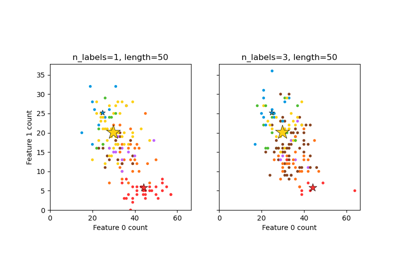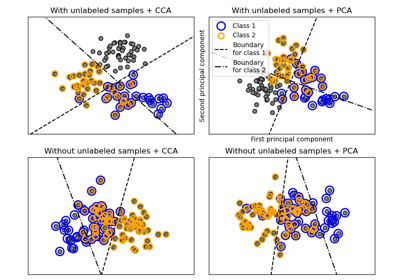sklearn.datasets.make_multilabel_classification¶
- sklearn.datasets.make_multilabel_classification(n_samples=100, n_features=20, *, n_classes=5, n_labels=2, length=50, allow_unlabeled=True, sparse=False, return_indicator='dense', return_distributions=False, random_state=None)[source]¶
Generate a random multilabel classification problem.
- For each sample, the generative process is:
pick the number of labels: n ~ Poisson(n_labels)
n times, choose a class c: c ~ Multinomial(theta)
pick the document length: k ~ Poisson(length)
k times, choose a word: w ~ Multinomial(theta_c)
In the above process, rejection sampling is used to make sure that n is never zero or more than
n_classes, and that the document length is never zero. Likewise, we reject classes which have already been chosen.For an example of usage, see Plot randomly generated multilabel dataset.
Read more in the User Guide.
- Parameters:
- n_samplesint, default=100
The number of samples.
- n_featuresint, default=20
The total number of features.
- n_classesint, default=5
The number of classes of the classification problem.
- n_labelsint, default=2
The average number of labels per instance. More precisely, the number of labels per sample is drawn from a Poisson distribution with
n_labelsas its expected value, but samples are bounded (using rejection sampling) byn_classes, and must be nonzero ifallow_unlabeledis False.- lengthint, default=50
The sum of the features (number of words if documents) is drawn from a Poisson distribution with this expected value.
- allow_unlabeledbool, default=True
If
True, some instances might not belong to any class.- sparsebool, default=False
If
True, return a sparse feature matrix.New in version 0.17: parameter to allow sparse output.
- return_indicator{‘dense’, ‘sparse’} or False, default=’dense’
If
'dense'returnYin the dense binary indicator format. If'sparse'returnYin the sparse binary indicator format.Falsereturns a list of lists of labels.- return_distributionsbool, default=False
If
True, return the prior class probability and conditional probabilities of features given classes, from which the data was drawn.- random_stateint, RandomState instance or None, default=None
Determines random number generation for dataset creation. Pass an int for reproducible output across multiple function calls. See Glossary.
- Returns:
- Xndarray of shape (n_samples, n_features)
The generated samples.
- Y{ndarray, sparse matrix} of shape (n_samples, n_classes)
The label sets. Sparse matrix should be of CSR format.
- p_cndarray of shape (n_classes,)
The probability of each class being drawn. Only returned if
return_distributions=True.- p_w_cndarray of shape (n_features, n_classes)
The probability of each feature being drawn given each class. Only returned if
return_distributions=True.
Examples
>>> from sklearn.datasets import make_multilabel_classification >>> X, y = make_multilabel_classification(n_labels=3, random_state=42) >>> X.shape (100, 20) >>> y.shape (100, 5) >>> list(y[:3]) [array([1, 1, 0, 1, 0]), array([0, 1, 1, 1, 0]), array([0, 1, 0, 0, 0])]

